�
AN INTRODUCTION
TO LTE
LTE, LTE-ADVANCED, SAE
AND 4G MOBILE COMMUNICATIONS
Christopher Cox
Director, Chris Cox Communications Ltd, UK
A John Wiley & Sons, Ltd., Publication
This edition first published 2012
© 2012 John Wiley & Sons Ltd
Registered office
John Wiley & Sons Ltd, The Atrium, Southern Gate, Chichester, West Sussex, PO19 8SQ, United Kingdom
For details of our global editorial offices, for customer services and for information about how to apply for
permission to reuse the copyright material in this book please see our website at www.wiley.com.
The right of the author to be identified as the author of this work has been asserted in accordance with the
Copyright, Designs and Patents Act 1988.
All rights reserved. No part of this publication may be reproduced, stored in a retrieval system, or transmitted, in
any form or by any means, electronic, mechanical, photocopying, recording or otherwise, except as permitted by
the UK Copyright, Designs and Patents Act 1988, without the prior permission of the publisher.
Wiley also publishes its books in a variety of electronic formats. Some content that appears in print may not be
available in electronic books.
Designations used by companies to distinguish their products are often claimed as trademarks. All brand names
and product names used in this book are trade names, service marks, trademarks or registered trademarks of their
respective owners. The publisher is not associated with any product or vendor mentioned in this book. This
publication is designed to provide accurate and authoritative information in regard to the subject matter covered.
It is sold on the understanding that the publisher is not engaged in rendering professional services. If professional
advice or other expert assistance is required, the services of a competent professional should be sought.
Library of Congress Cataloging-in-Publication Data
Cox, Christopher (Christopher Ian), 1965-
An introduction to LTE : LTE, LTE-advanced, SAE and 4G mobile communications / Christopher Cox.
p. cm.
Includes bibliographical references and index.
ISBN 978-1-119-97038-5 (cloth)
1. Long-Term Evolution (Telecommunications) 2. Mobile communication systems – Standards. I. Title.
TK5103.48325.C693 2012
621.3845’6 – dc23
2011047216
A catalogue record for this book is available from the British Library.
Print ISBN: 9781119970385
Set in 10/12 Times by Laserwords Private Limited, Chennai, India
�
To my nieces, Louise and Zoe
�
Contents
Preface
Acknowledgements
List of Abbreviations
1
1.1
1.2
1.3
1.4
1.5
1.6
2
2.1
High Level Architecture
Architecture of the Radio Access Network
Architecture of the Core Network
Communication Protocols
From 1G to 3G
Third Generation Systems
The Growth of Mobile Data
Capacity of a Mobile Telecommunication System
Increasing the System Capacity
Additional Motivations
Introduction
Architectural Review of UMTS and GSM
1.1.1
1.1.2
1.1.3
1.1.4
History of Mobile Telecommunication Systems
1.2.1
1.2.2
The Need for LTE
1.3.1
1.3.2
1.3.3
1.3.4
From UMTS to LTE
1.4.1
1.4.2
1.4.3
From LTE to LTE-Advanced
1.5.1
1.5.2
1.5.3
1.5.4
The 3GPP Specifications for LTE
References
The ITU Requirements for 4G
Requirements of LTE-Advanced
4G Communication Systems
The Meaning of 4G
High Level Architecture of LTE
Long Term Evolution
System Architecture Evolution
System Architecture Evolution
Architecture of LTE
2.1.1
2.1.2
2.1.3
High Level Architecture
User Equipment
Evolved UMTS Terrestrial Radio Access Network
xvii
xix
xxi
1
1
1
2
4
4
6
6
7
8
8
10
11
11
11
11
12
13
15
15
15
15
16
16
18
21
21
21
21
23
�
Evolved Packet Core
Roaming Architecture
Network Areas
Numbering, Addressing and Identification
2.1.4
2.1.5
2.1.6
2.1.7
Communication Protocols
2.2.1
Protocol Model
Air Interface Transport Protocols
2.2.2
Fixed Network Transport Protocols
2.2.3
User Plane Protocols
2.2.4
2.2.5
Signalling Protocols
Example Information Flows
2.3.1
2.3.2
2.3.3
Bearer Management
2.4.1
2.4.2
2.4.3
2.4.4
State Diagrams
2.5.1
2.5.2
2.5.3
Spectrum Allocation
References
The EPS Bearer
Tunnelling Using GTP
Tunnelling Using GRE and PMIP
Signalling Radio Bearers
Access Stratum Signalling
Non Access Stratum Signalling
Data Transport
EPS Mobility Management
EPS Connection Management
Radio Resource Control
Digital Wireless Communications
Radio Transmission and Reception
3.1.1
3.1.2
3.1.3
3.1.4
3.1.5
Signal Transmission
Signal Reception
Channel Estimation
Multiple Access Techniques
FDD and TDD Modes
viii
2.2
2.3
2.4
2.5
2.6
3
3.1
3.3
4
4.1
3.2 Multipath, Fading and Inter-Symbol Interference
3.2.1
3.2.2
Error Management
3.3.1
3.3.2
3.3.3
References
Multipath and Fading
Inter-Symbol Interference
Forward Error Correction
Automatic Repeat Request
Hybrid ARQ
Orthogonal Frequency Division Multiple Access
Orthogonal Frequency Division Multiplexing
4.1.1
4.1.2
4.1.3
Reduction of Inter-Symbol Interference using OFDM
The OFDM Transmitter
Initial Block Diagram
Contents
24
25
26
27
28
28
29
30
31
31
33
33
33
35
36
36
37
38
39
40
40
40
41
42
44
47
47
47
49
50
51
52
53
53
55
56
56
57
58
60
61
61
61
62
65
�
Contents
4.2
4.3
5
5.1
5.2
5.3
6
6.1
6.2
6.3
Multiple Access
Fractional Frequency Re-Use
Channel Estimation
Cyclic Prefix Insertion
Use of the Frequency Domain
Choice of Sub-Carrier Spacing
OFDMA in a Mobile Cellular Network
4.2.1
4.2.2
4.2.3
4.2.4
4.2.5
4.2.6
Single Carrier Frequency Division Multiple Access
4.3.1
4.3.2
References
Power Variations from OFDMA
Block Diagram of SC-FDMA
Receive Diversity
Closed Loop Transmit Diversity
Open Loop Transmit Diversity
Multiple Antenna Techniques
Diversity Processing
5.1.1
5.1.2
5.1.3
Spatial Multiplexing
5.2.1
5.2.2
5.2.3
5.2.4
5.2.5
5.2.6
Beamforming
5.3.1
5.3.2
5.3.3
5.3.4
References
Principles of Operation
Open Loop Spatial Multiplexing
Closed Loop Spatial Multiplexing
Matrix Representation
Implementation Issues
Multiple User MIMO
Principles of Operation
Beam Steering
Dual Layer Beamforming
Downlink Multiple User MIMO Revisited
Logical Channels
Transport Channels
Physical Data Channels
Control Information
Physical Control Channels
Physical Signals
Information Flows
Architecture of the LTE Air Interface
Air Interface Protocol Stack
Logical, Transport and Physical Channels
6.2.1
6.2.2
6.2.3
6.2.4
6.2.5
6.2.6
6.2.7
The Resource Grid
6.3.1
6.3.2
6.3.3
6.3.4
6.3.5
Slot Structure
Frame Structure
Uplink Timing Advance
Resource Grid Structure
Bandwidth Options
ix
66
66
67
68
69
70
72
72
72
73
76
77
77
77
78
79
80
80
82
84
85
88
88
90
90
91
92
93
94
95
95
97
97
97
98
99
100
100
101
101
101
103
105
106
106
�
x
Contents
6.4 Multiple Antenna Transmission
Downlink Antenna Ports
Downlink Transmission Modes
6.4.1
6.4.2
Resource Element Mapping
6.5.1
6.5.2
References
Downlink Resource Element Mapping
Uplink Resource Element Mapping
Physical Cell Identity
Primary Synchronization Signal
Secondary Synchronization Signal
Cell Acquisition
Acquisition Procedure
Synchronization Signals
7.2.1
7.2.2
7.2.3
Downlink Reference Signals
Physical Broadcast Channel
Physical Control Format Indicator Channel
System Information
7.6.1
7.6.2
Procedures After Acquisition
References
Organization of the System Information
Transmission and Reception of the System Information
107
107
107
109
109
109
112
113
113
114
114
115
116
116
117
118
119
119
121
121
122
123
123
123
125
126
127
127
128
129
130
131
132
132
133
135
135
136
136
137
137
137
138
139
6.5
7
7.1
7.2
7.3
7.4
7.5
7.6
7.7
8
8.1
8.2
8.3
8.4
8.5
Downlink Transmission and Reception
Uplink Transmission and Reception
Semi Persistent Scheduling
Downlink Control Information
Resource Allocation
Example: DCI Format 1
Radio Network Temporary Identifiers
Transmission and Reception of the PDCCH
Data Transmission and Reception
Data Transmission Procedures
8.1.1
8.1.2
8.1.3
Transmission of Scheduling Messages on the PDCCH
8.2.1
8.2.2
8.2.3
8.2.4
8.2.5
Data Transmission on the PDSCH and PUSCH
8.3.1
8.3.2
Transmission of Hybrid ARQ Indicators on the PHICH
8.4.1
8.4.2
8.4.3
Uplink Control Information
8.5.1
8.5.2
8.5.3
8.5.4
Introduction
Resource Element Mapping of the PHICH
Physical Channel Processing of the PHICH
Hybrid ARQ Acknowledgements
Channel Quality Indicator
Rank Indication
Precoding Matrix Indicator
Transport Channel Processing
Physical Channel Processing
�
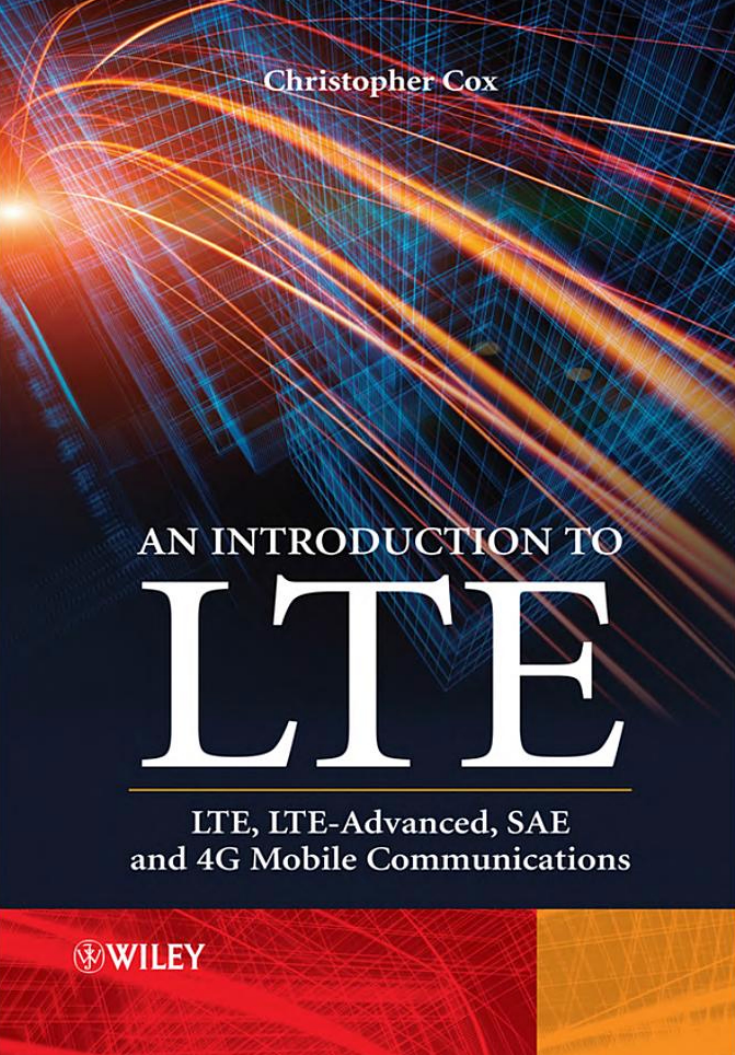

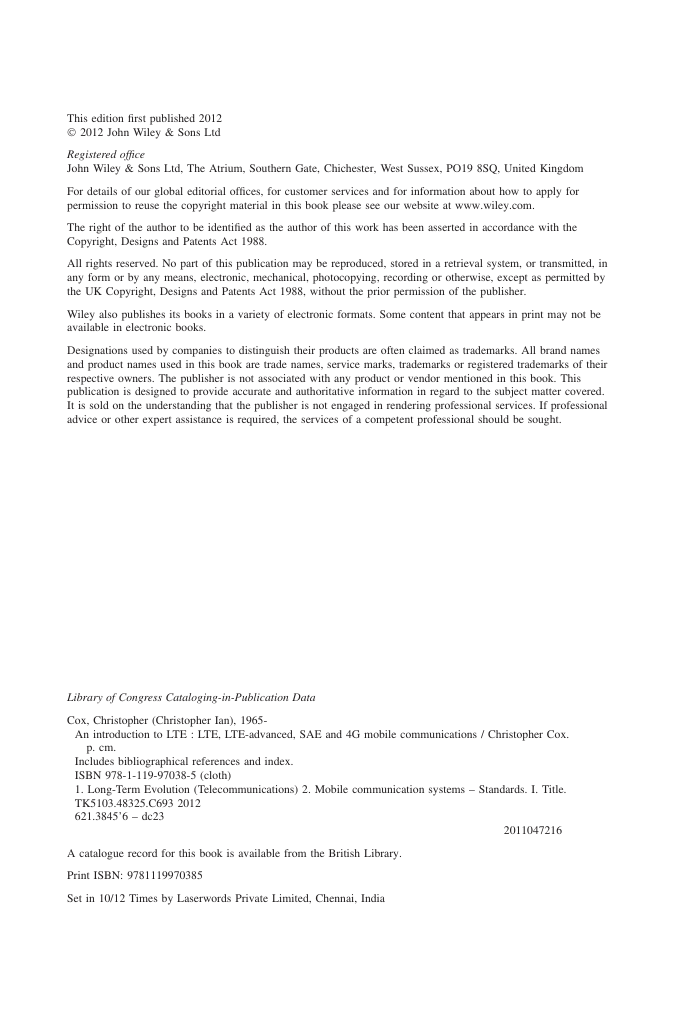

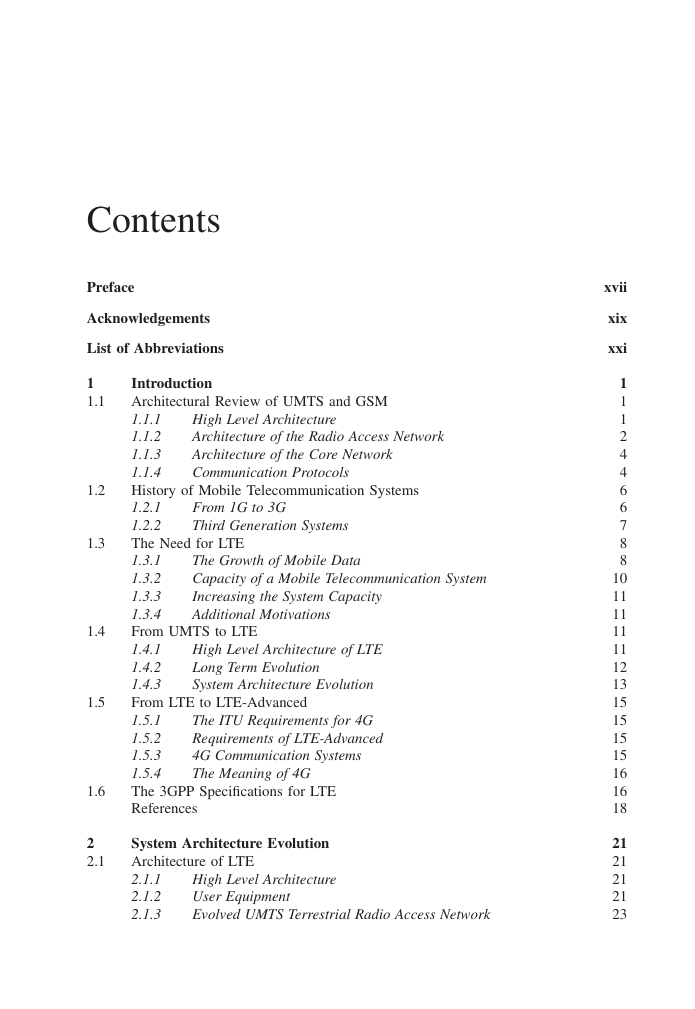
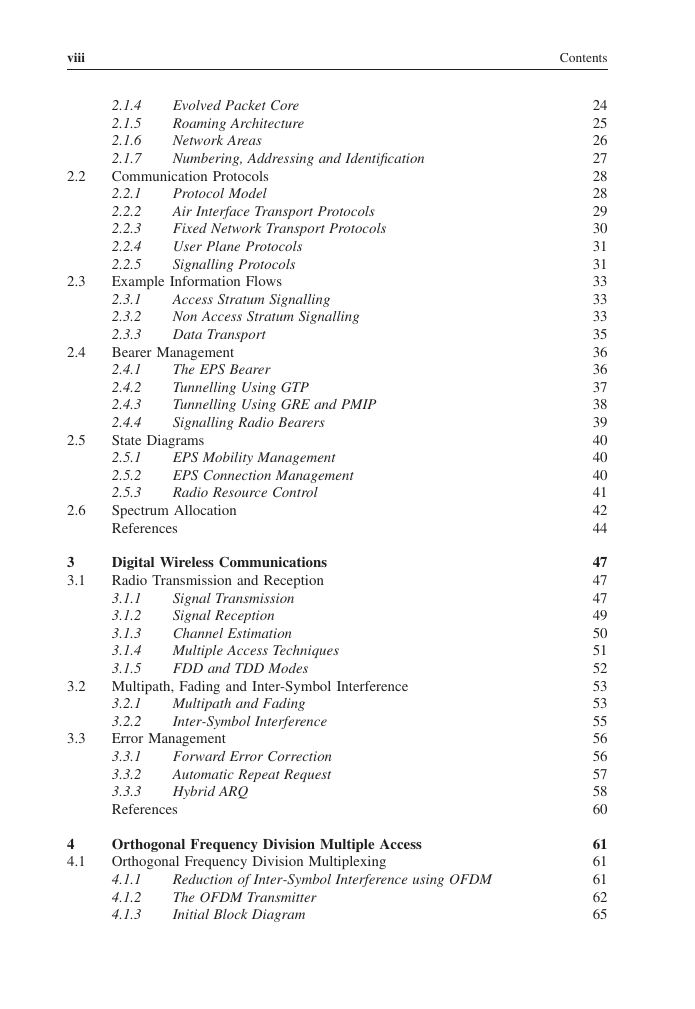

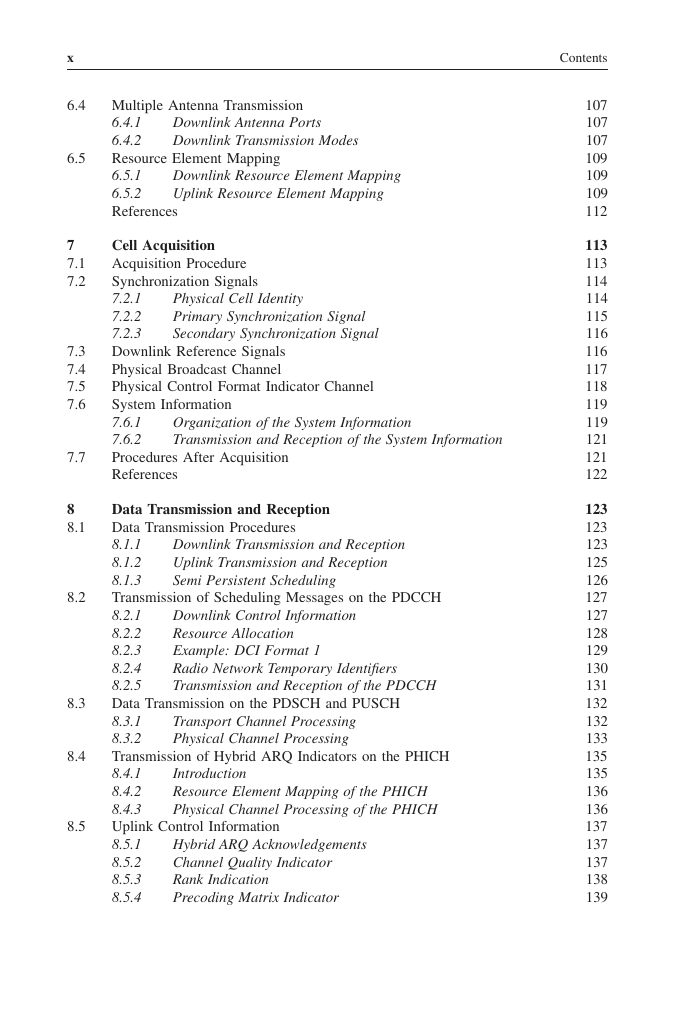








 2023年江西萍乡中考道德与法治真题及答案.doc
2023年江西萍乡中考道德与法治真题及答案.doc 2012年重庆南川中考生物真题及答案.doc
2012年重庆南川中考生物真题及答案.doc 2013年江西师范大学地理学综合及文艺理论基础考研真题.doc
2013年江西师范大学地理学综合及文艺理论基础考研真题.doc 2020年四川甘孜小升初语文真题及答案I卷.doc
2020年四川甘孜小升初语文真题及答案I卷.doc 2020年注册岩土工程师专业基础考试真题及答案.doc
2020年注册岩土工程师专业基础考试真题及答案.doc 2023-2024学年福建省厦门市九年级上学期数学月考试题及答案.doc
2023-2024学年福建省厦门市九年级上学期数学月考试题及答案.doc 2021-2022学年辽宁省沈阳市大东区九年级上学期语文期末试题及答案.doc
2021-2022学年辽宁省沈阳市大东区九年级上学期语文期末试题及答案.doc 2022-2023学年北京东城区初三第一学期物理期末试卷及答案.doc
2022-2023学年北京东城区初三第一学期物理期末试卷及答案.doc 2018上半年江西教师资格初中地理学科知识与教学能力真题及答案.doc
2018上半年江西教师资格初中地理学科知识与教学能力真题及答案.doc 2012年河北国家公务员申论考试真题及答案-省级.doc
2012年河北国家公务员申论考试真题及答案-省级.doc 2020-2021学年江苏省扬州市江都区邵樊片九年级上学期数学第一次质量检测试题及答案.doc
2020-2021学年江苏省扬州市江都区邵樊片九年级上学期数学第一次质量检测试题及答案.doc 2022下半年黑龙江教师资格证中学综合素质真题及答案.doc
2022下半年黑龙江教师资格证中学综合素质真题及答案.doc